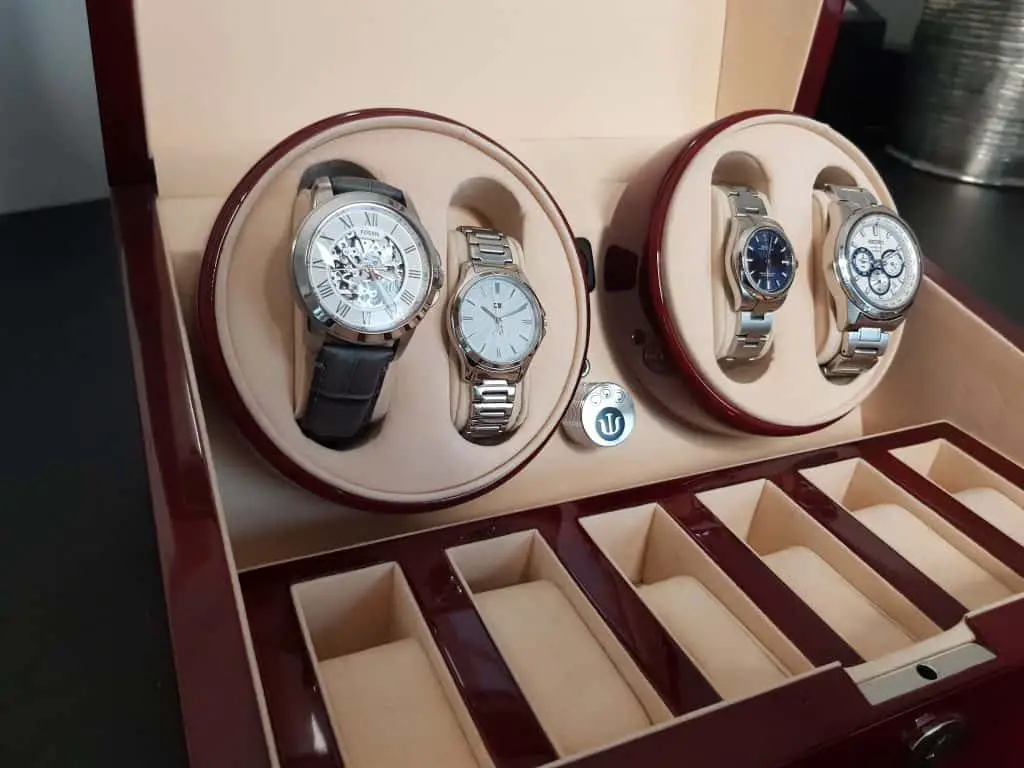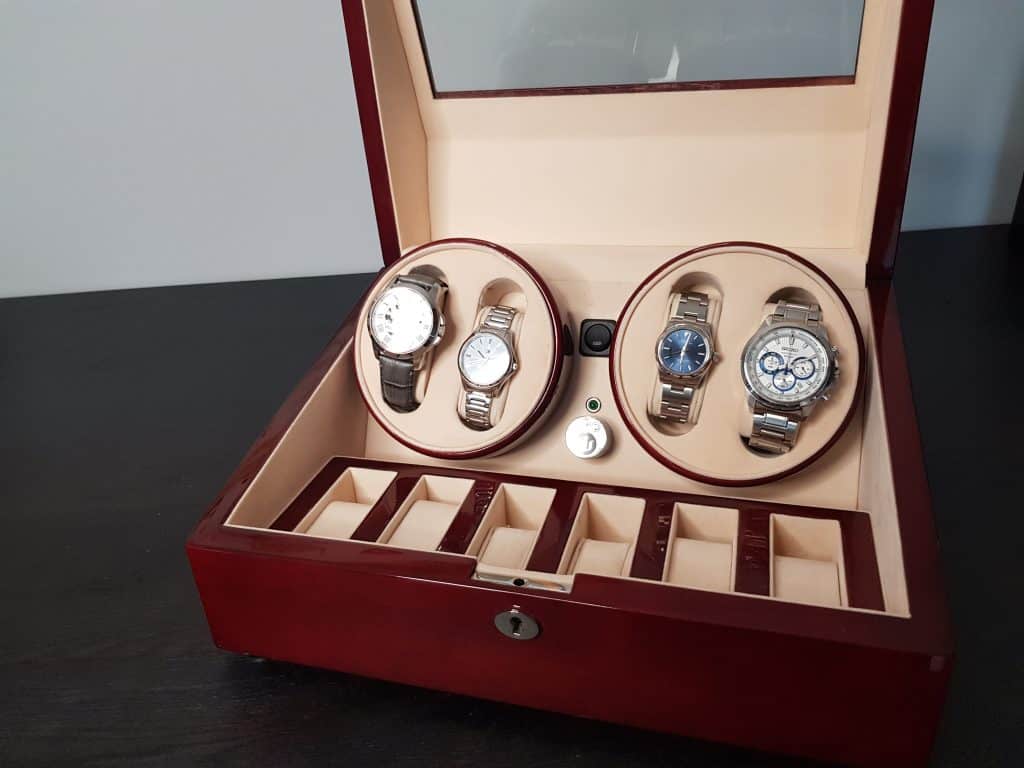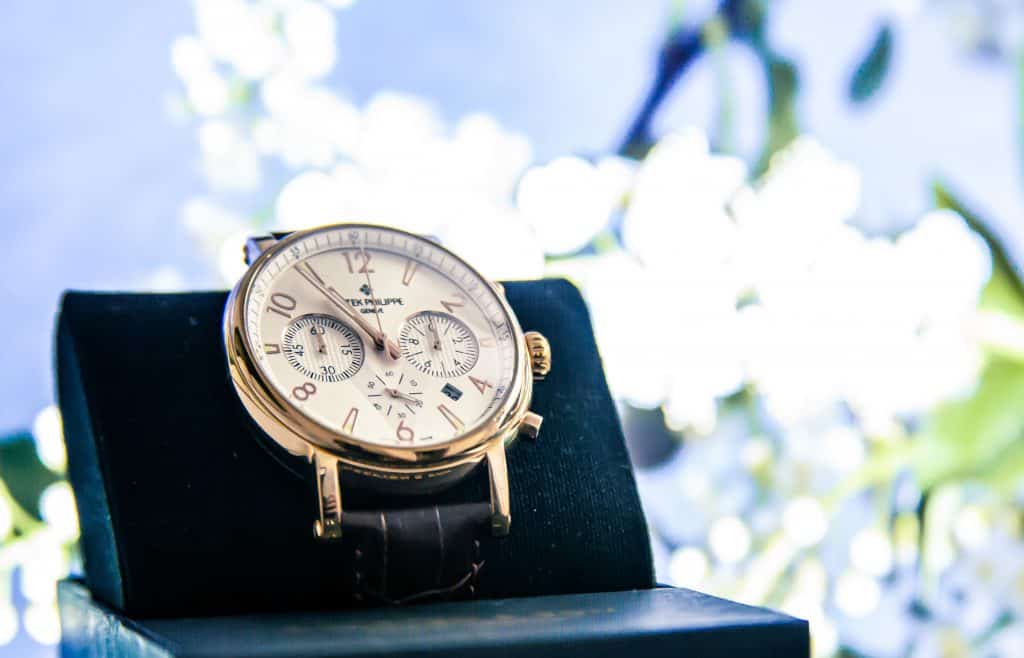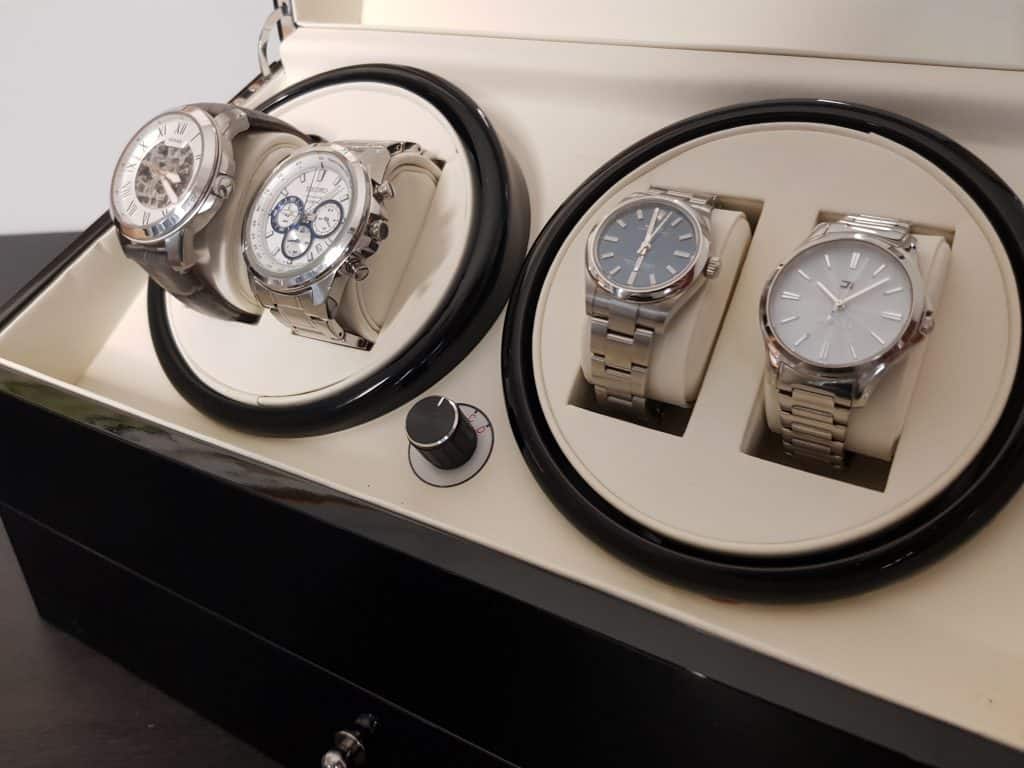Ah, so you decided to take the plunge and purchase your first watch winder for your timepiece collection – congratulations! But before you buy, it’s essential to take a little time to research which device may suit you best. So what should you look for when buying your first watch winder?
When buying your first watch winder, it’s important to note the number of watches it can hold, its portability, power source, and program settings.
No matter the price tag, we understand that purchasing a watch winder is an investment, and you want to buy the best one for your horologic needs – the first time. That’s why we’ve put together this handy guide on what to look for when buying your very first watch winder. We’ll go over eight factors to note so when you’re shopping for a device, you can make the best decision for yourself. We’ll also talk about variations in the cheaper and more expensive device models, plus go over what watch winder safes are!

Table of Contents
What To Look For When Buying A Watch Winder
When buying a watch winder, look for an aesthetic design that you like and check out its features. A watch winder shouldn’t just look great on a dresser or work wonderfully – it should do both!
There are eight key factors you’ll want to consider when buying your very first watch winder, like how many watches it can hold, how portable it is, its power source, program settings, quality of materials, and noise level of the machine.
Though all watch winders have the same function – to wind an automatic watch when it’s not worn – certainly not all watch winders are created equal.
Let’s go over eight key factors you’ll want to keep in mind when shopping for your first (maybe next!) watch winder.
The Number Of Watches Your Winder Can Hold
Watch winders come in different shapes and sizes, so the first thing you want to notice is how many watch slots the watch winder has. The number of slots indicates the number of watches the device will be able to hold.
It’s also important to note how many automatic watches you own.
Watch winders only work on automatic watches (you can read more about watch winder basics here), so you’ll only need enough slots to fit that type of watch – not for your mechanical, kinetic, or quartz timepieces.
Of course, you can still place these other types of watches in your winder; it just won’t do anything.
Aside from knowing how many (automatic) watches you own, it’s also important to know if there are any additional watches coming soon. You don’t want to buy a watch winder that holds two watches, only to purchase a third or fourth watch a few weeks or months later. It’s always best to upsize just a little bit!
How Portable Is The Watch Winder
After you determine how many watch slots you’ll need, think about how and where you may use the watch winder. Do you often travel for work or pleasure, or are you a homebody?
If you’re the travel type or you must jet off due to work, a small, compact watch winder is your best option. These are typically sized a little larger than the box your watch originally came in and can easily be put into a safe when you’re staying at a hotel. Compact watch winders are usually battery-powered, so you don’t have to worry about finding a power source or keeping your precious timepiece in the open while out of the safe.
Alternatively, if portability isn’t an issue, you can get a larger AC-powered watch winder which must be plugged into a power outlet to work. These are not as readily portable. Some devices may be the size of a gift box, while others are the size of a full-scale standing safe (these are safes with watch winders built-in, but we’ll discuss that in a bit!).
No matter the size of the watch winder, most people choose to keep their devices in their bedroom or closet, either on the dresser, shelf, or floor.
What Power Source Does Your Watch Winder Need

Next, you’ll want to think about where the device must get its power. This corresponds with how you think you’ll be using your watch winder (see above) – whether you’re out traveling and constantly in and out of hotels or maintain a home base.
Most of the compact watch winders run on AA batteries, called DC watch winders. You’ll see this in a product description as “DC watch winder” or “DC powered watch winder.” With these watch winders, it’s common to get anywhere between 6-12 months of battery life. Some brands design their compact devices to have the option of plugging into a wall outlet via an AC/DC adapter.
As we mentioned in the above section, larger watch winders are usually powered by being plugged into a wall outlet. These are AC-powered watch winders.
We recommend finding a watch winder that strikes a balance between both power sources, so look for devices that use rechargeable batteries as well as can be fitted with a power adapter.
This opens up both options for you. If you’re just at home, have it plugged into a power outlet, and if you’re traveling or the power is out, you can have it run on the batteries.
What Program Settings Does The Winder Have
Program settings are another important factor when choosing a watch winder. Look for devices with multiple programmable turning direction options for turns per day (TPD), so each automatic watch in your collection can be fine-tuned accordingly. Different watches require different minimums of turns per day, and this setting also varies from watch winder to winder.
For example, Swiss luxury brands Rolex and Omega have watches that need about 650 turns per day to stay fully wound; Patek Philippe, on average, needs 800. If you’re unsure of what program settings or turns per day your watch requires, you can look it up in the user’s guide or search for your watch model online.
You’ll also want to check that the winder can rotate your watch bidirectionally, aka in multiple directions: clockwise and counterclockwise. The direction variation helps your watch get a full charge as if it were on your wrist.
What Are The Noise Levels And Light Effects Of Your Watch Winder
Though seemingly trivial, the noise level is something to consider, and not everyone is affected by noise and light the same way, so this can be a bit subjective. Luckily, most watch winders of today are silent, quiet, or don’t make a sound above a faint hum when running, whether plugged into the wall or are battery-powered.
While many machines have improved from the sleep-disturbing noise of decades past, noisy machines are still a common complaint to find amongst watch winder owners. If you’re sensitive to noise, it’s definitely worth it to investigate beforehand.
You also should check that the watch winder in question does not have too many/too bright lights that could hinder your snooze sessions should you keep the device in your bedroom. If not kept in the bedroom, the lights could look really nice, but once again, that’s subjective.
How Are The Watches Positioned Within The Winder
Check how your watch will be positioned in the watch winder. Ideally, watches should be sat vertically or nearly vertical. A watch positioned vertically gets its rotor tuned more efficiently than a watch placed horizontally due to the force of gravity during each rotation.
A vertical position in the watch winder also helps the watch gears not catch or stall. Luckily, most watch winders have a (near) vertical position of the watches, but it’s always good to give it an extra look.
Does The Winder Contain Watch Holders, Cushions, Or Pillows

A watch winder will have a watch holder for you to rest your watch so it can be rotated and not fall off. Cushions and pillows are most common, though make sure it is plush enough to fit your watch without overstretching. Remember that not everyone has the same sized wrist or watch bracelet, so one size of watch holder does not necessarily fit all.
On the flip side, some watch winders may have a spring-loaded holder instead. These provide better tension to your watch to hold it in place than pillows and cushions.
Ultimately, your watch winder should have watch holder options for various watches and watch strap sizes.
How Does The Watch Winder Look
Lastly, think about how the look of a watch winder will coexist with your current collection and decor. Watch winders come in different shapes (square, round), sizes (compact, vault-size), and colors (like mahogany, blue, and black.)
Watch winders are not only functional, but they also look stunning and classy. Many people enjoy having a watch winder on display, regardless of whether or not they’re actually using it. And if you do purchase one for the functionality, there’s no reason why you shouldn’t get a watch winder that looks as good as the watch you’re about to place inside it, right?
Why Do I Need A Watch Winder?
A watch winder keeps your automatic watches wound. This ensures that the watch keeps on ticking, even if it’s not worn. Automatic watches require movement to function, so a watch winder helps with that.
A watch winder is a great tool to ensure that your watch stays fully wound and ready to wear if you have an automatic watch. Watch winders are especially useful when you have a collection of automatic time tickers that you routinely switch out and sport. Once you’re done wearing the watch, put it in the watch winder until you’re ready to wear it again.
I talk more about whether or not you need a watch winder here.
Are Watch Winders Expensive?

Good watch winders can be expensive since only experts can put them together using high-quality materials. They are also equipped with more features and stronger safety mechanisms to prevent overtuning and magnetization of your watch.
Excluding the lavishly priced watch winders in the tens of thousands of dollars – watch winders on the more expensive side start around $300 and upwards. But why?
More watch slots and rotation settings equal a higher price point. More robust safety mechanisms that safeguard your watch against damage also drive up the cost. Brands such as Cheopz, Rapport London, and Wolf Designs are some of the top pricier watch winders. You can read more about the price of watch winders in this article here!
What’s The Difference Between Cheaper And More Expensive Watch Winders?
Cheaper watch winders are still excellent tools to have as part of your collection, even though they may not have robust features or high-quality safety precautions as pricier devices. Affordable options start at around $50.
Winders on the lower price scale may not be able to rotate your watch in multiple directions and may not have a rotation setting timer to pause the process, giving your watch the necessary rest periods. Cheaper winders will also not hold more than two watches or so.
Like a house, the more watch winder you get, the more you pay for!
What Are Watch Winder Safes?
Watch winder safes are exactly what they sound like – a safe with a built-in watch winder. These devices are typically placed in walk-in closets and bedrooms. They are usually very expensive.
To get an idea, check out the gorgeous Grand Collector by Buben & Zorweg. It features a clock at the top and individual winders for dozens of watches, plus code-operated locks to keep the goods safe.
Watch winder safes aren’t for all of us – but if you’re a bonafide watch aficionado – and have loads of cash – go for it!
